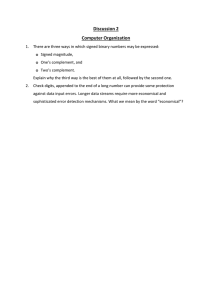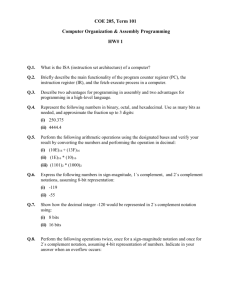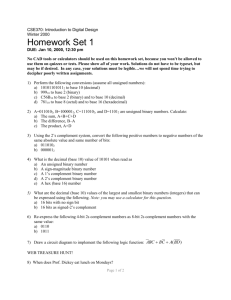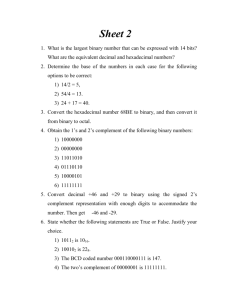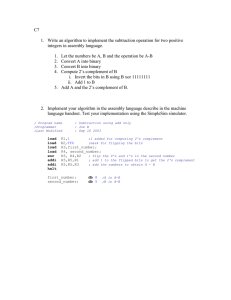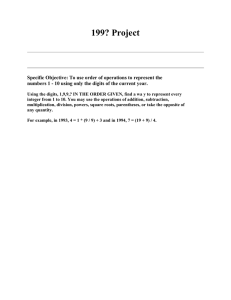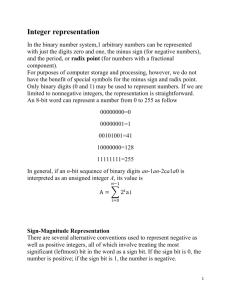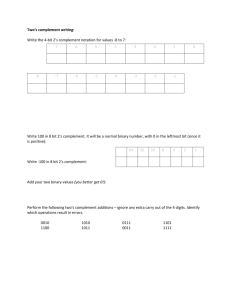Computer Science 1000 Digital Information
advertisement
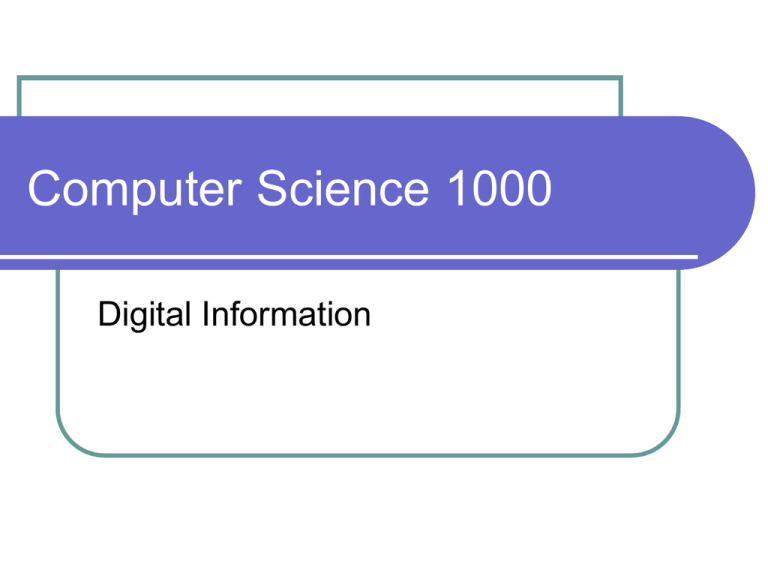
Computer Science 1000
Digital Information
Arithmetic
we have seen how to represent numbers in other
bases
how about manipulating numbers in other bases
for example, how can we add two binary numbers?
as it turns out, we can, using the same technique
as you learned in grade school
do a digit-by-digit addition of both numbers
be sure to add in carry digit when necessary
Example: Add 1287 to 1432
Step 1: Add the last two digits
1287
+1432
Example: Add 1287 to 1432
Step 2: Add the next two digits
note that this results in a carry digit
1287
+1432
9
Example: Add 1287 to 1432
Step 3: Add the next two digits
be sure to add in the carry digit
1
1287
+1432
19
Example: Add 1287 to 1432
Step 4: Add the final two digits
be sure to add in the carry digit
1
1287
+1432
719
Example: Add 1287 to 1432
Step 4: Add the final two digits
be sure to add in the carry digit
1
1287
+1432
2719
Adding Binary Numbers
given the process for adding two decimal numbers
1
1287
+1432
2719
can we do the same thing with binary numbers?
Adding Binary Numbers
yes, we can
add each two corresponding digits, plus carry (if any)
propagate new carry digit (if any)
1011
+0010
Adding Binary Numbers
in order to add single bits together, we need
to remember a few conversions:
Dec
0
1
2
3
Bin
0
1
10
11
Example:
Step 1: Add last two digits (in binary)
1+0=1
no carry bit
1011
+0010
1
Dec
0
1
2
3
Bin
0
1
10
11
Example:
Step 2: Add second-last two digits (in binary)
1 + 1 = 10
there is a carry bit
1
1011
+0010
01
1
Dec
0
1
2
3
Bin
0
1
10
11
Example:
Step 3: Add second two digits (plus carry)
1+0+0=1
there is no carry bit
1
1011
+0010
101
01
1
Dec
0
1
2
3
Bin
0
1
10
11
Example:
Step 4: Add first two digits
1+0=1
there is no carry bit
1
1011
+0010
1101
101
01
1
Dec
0
1
2
3
Bin
0
1
10
11
Check:
1011
+0010
_____
1101
table shows correct
computation of 11 + 2 = 13
Decimal
Binary
Decimal
Binary
0
0000
8
1000
1
0001
9
1001
2
0010
10
1010
3
0011
11
1011
4
0100
12
1100
5
0101
13
1101
6
0110
14
1110
7
0111
15
1111
Signed Integers
our discussion so far has focused on non-negative
integers
computers permit the storage and manipulation of
signed numbers, which includes both positive and
negative numbers
different ways for representing signed numbers
sign-magnitude
two's complement
Signed Integers
let's first consider the decimal case
recall: integer is a sequence of digits
padded with leading zeroes, if necessary
00001234
how do we represent negative numbers?
Sign-Magnitude
instead of storing a digit in the first symbol of the sequence,
let's store a special character
our previous example becomes:
+0001234
to store a negative number, switch the symbol
+ : number is positive
- : number is negative
-0001234
note that if the number of symbols being stored remains the
same, then we must give one digit up to store the negative
sign
Sign-Magnitude
the previously described representation is often
referred to as sign-magnitude
first symbol: stores sign of number (+/-)
remaining symbols: stores the magnitude (size) of number
one of the primary advantages of sign-magnitude is its
familiarity
people typically represent negative numbers using a leading –
although the leading + is often omitted when writing numbers, it
is still familiar (e.g. most people know what +56 means)
Sign-Magnitude
Question: Given x symbols (digits and sign), what is the
largest number that can be represented using signmagnitude?
Consider: an x-symbol, sign-magnitude number has two parts
first part: sign (+/-) : 1 symbol
second part: magnitude: x-1 digits
to make the largest number possible, set the sign to +, and the digits
to 9s
4 symbols:
6 symbols:
+999
+99999
Sign-Magnitude
Question: Given x symbols (digits and sign), what is the
largest number that can be represented using signmagnitude?
Answer: 10x-1 - 1
this follows from our previous discussion, as we now only have x-1 bits
with which to represent the magnitude of the number
this also means that the smallest number we can store is – (10x-1 - 1), by
flipping the + to a -
Binary Sign-Magnitude
sign magnitude works the same in binary
however, when using binary, a simplifying assumption is
typically made
positive number: set left-most bit to zero
negative number: set left-most bit to one
this assumption means that the number still only requires 1s
and 0s
example: store 6 and -6 in binary (4 bits)
6: 0110
-6: 1110
Binary Sign-Magnitude
limits on number similar to decimal case
Given x symbols:
Base
Largest
Smallest
Decimal (10)
10x-1 -1
-(10x-1 -1)
Binary (2)
2x-1 -1
-(2x-1 -1)
Example:
3 bits: -3 ... 3
5 bits: -15... 15
Example: Given the sequence of binary digits 1010,
what is the equivalent number in decimal if this is (a)
an unsigned integer and (b) a signed integer?
Solution (a): Recall our algorithm for converting
binary digits to its decimal number
1010 = 1 x 23
+ 0 x 22
+ 1 x 21
+ 0 x 20 = 10
Example: Given the sequence of binary digits 1010,
what number is being represented if this represents (a)
an unsigned integer and (b) a signed integer?
Solution (b): Use the algorithm from before, but ignore the leftmost bit
1010 = 0 x 22
+ 1 x 21
+ 0 x 20 = 2
then use the left-most bit to determine the sign
since it's 1, we know that the number is negative:
-2
Sign-Magnitude
although sign-magnitude is intuitive, it does suffer from
several drawbacks
1) Two representations for zero:
4 bit: 0000 and 1000
this requires special case functionality in certain circumstances
e.g. 0000 and 1000 must be determined to be equal
Sign-Magnitude
although sign-magnitude is intuitive, it does suffer from
several drawbacks
2) Special code needed for negative arithmetic
e.g. addition
our previous addition function would not work correctly if the number
is negative
additional code would need to be written
this may seem trivial, except that low-level arithmetic is often built
into hardware
Two's Complement
a different way to represent signed numbers
unlike sign-magnitude, all digits in two's
complement represent a coefficient to be multiplied
to a power of 2
in fact, the representation is nearly identical to the
positive (unsigned) version, with one simple
exception:
the first power is assumed to be negative
Recall our algorithm for converting binary digits to its
actual number
1010 = 1 x 23
+ 0 x 22
+ 1 x 21
+ 0 x 20 = 10
in two's complement, the first power is negative
1010 = 1 x –(23)
+ 0 x 22
+ 1 x 21
+ 0 x 20 = -6
Example: What is the decimal representation of the
binary number 1111, assuming two's complement?
1111 = 1 x –(23)
+ 1 x 22
+ 1 x 21
+ 1 x 20 = -1
Two's Complement – Observations
for positive numbers, the sign-magnitude and two's
complement representation are identical
negative numbers always have their left-most bit set to one in
both representations
e.g. 610 = 01102 for both representations
remember: for two's complement, the left-most bit represents magnitude
as well
for negative numbers, a sequence of all 1s represents -1 in
two's complement, or the largest negative number
this is the opposite of sign-magnitude, where all 1s represented the
smallest negative number (11112 = -710)
see previous slide for example
Two's Complement
given x bits, what is the largest two's
complement number that we can represent?
Answer: 2x-1 - 1
previous slide says that positive sign-magnitude
and two's complement numbers are identical
therefore, largest sign-magnitude number and
two's complement number are the same
Two's Complement
given x bits, what is the smallest two's
complement number that we can represent?
the answer is perhaps not as clear, as two's
complement and sign-magnitude differ
considerably in representation of negative
numbers
let's consider a specific example
Recall our breakdown of a two's complement number
1111 = 1 x –(23)
+ 1 x 22
+ 1 x 21
+ 1 x 20 = -1
what should our digits be set to, to produce the smallest
number?
set left-most bit to one, and all others to zero
Two's Complement
given x bits, what is the smallest two's
complement number that we can represent?
Answer:
-(2x-1)
accomplished by setting first bit to one, and all
others to zero
hence, range of two's complement number with
x bits is -(2x-1) ... 2x-1 - 1
Example: given an integer of size 5 bits, what
would the range of the integer be if it is:
a) unsigned
b) signed (sign-magnitude)
0 ... 2x -1 = { 0 ... 31}
- (2x-1 -1) .. (2x-1 -1) = { -15... 15}
c) signed (two's complement)
- (2x-1) .. (2x-1 -1) = { -16 ... 15}
Sign Extension
recall with unsigned numbers, we could
increase number of bits of any number by
adding leading zeroes
e.g. 6
using 4 bits:
using 8 bits:
0110
00000110
what do we do with signed numbers?
Sign Extension
sign-magnitude
with sign-magnitude, we can also add leading
zeroes, but only after the sign bit
e.g. -6
4 bit:
8 bit:
1110
10000110
Sign Extension
two's complement
we pad the left side of the number with the left-most bit
this is often referred to as sign-extension
e.g. 6
positive: pad with zeroes
negative: pad with ones
4 bit: 0110
8 bit: 00000110
e.g. -6
4 bit: 1010
8 bit: 11111010
Check:
11111010 =
1 x –(27)
+ 1 x 26
+ 1 x 25
+ 1 x 24
+ 1 x 23
+ 0 x 22
+ 1 x 21
+ 0 x 20 = -6
